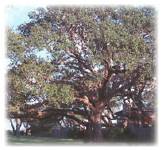Panhandle Plantings

It's time to think TREES!
One of the toughest gardening decisions you'll ever have to make is what tree to plant where. Unlike annuals and some small perennials, you canít easily correct your tree planting mistakes on a seasonal basis. Trees provide the form and structure to a landscape, defining our "'style" season after season. This is a long-term commitment that canít be rushed Ė well, it can be Ė but we may not want to accept the consequences.
Shortly after Opal hit the area in 1994, Okaloosa County Extension Agent Larry Williams ran an article called "Selecting and Planting Trees after a Hurricane." The information in this article stuck with me, unlike my copy of the article itself, and I recently asked him to resurrect a copy for me. What follows is a paraphrase of that article Ė information that you might never have considered in choosing the trees youíre going to be spending your life with.
In our world of instant gratification, we move into a home and require that the landscape be fully developed by the time supper is ready that first evening. Sometimes we feel magnanimous and decide that weíll give it 30 days to "mature." The result of this attitude is the purchase of "fast-growing" plants that arenít always the best choice.
Thereíre two problems with this approach as it pertains to trees. First, most fast-growing trees share characteristics such as weak wood, or splitting, cracking or breaking due to form Ė all factors that donít bode well for withstanding heavy storm conditions. Second, as a general rule, fast-growing trees are short-lived, defined as a 15- to 30-year life span, versus something like a live oak that can reach 200 years old and beyond.
Another problem with trees in the home landscape is space, specifically root room. Large-growing trees that are squeezed into small spaces close to curbs, driveways, sidewalks or buildings canít develop the proper root foundation; thus you have an enormous canopy and nothing to ground it in adverse conditions. Itís recommended that a medium- or large-growing tree be provided approximately 400 square feet of space to develop its root structure.
That's all the bad news. The good news is that the U. S. Department of Agriculture Forest Service has a list of trees rated from most-to-least resistant to storm damage given proper growth habitat. Not all of these trees are appropriate for our area, so be sure to do your homework. Now, without further ado, here they are:
Live Oak,
Baldcypress,
Blackgum,
Sweetgum,
Southern Red Oak,
Magnolia,
White Oak,
Beech,
Sugar Maple,
Sycamore,
Ash,
Longleaf Pine,
Loblolly Pine,
Slash Pine,
Red Cedar,
Water Oak,
Cherry,
Silver Maple,
Dogwood,
Basswood,
Yellow Poplar,
Red Maple,
Hickory,
and Boxelder
Granted, not many of us are going to live to see that Live Oak in 200-year-old glory, but think about how much you appreciate the grand old trees of Northwest Florida. Wouldn't it be nice to imagine that someone 100 years from now thinks kindly of you for having some foresight?
Val Ford is a Holmes County Master Gardener. If you have a gardening question or problem, contact your local County Extension Office or e-mail Val at FLSnowflake7592@aol.com
Page created and maintained by West Florida Electric Cooperative, Inc. © 2001.
designed by embryo design